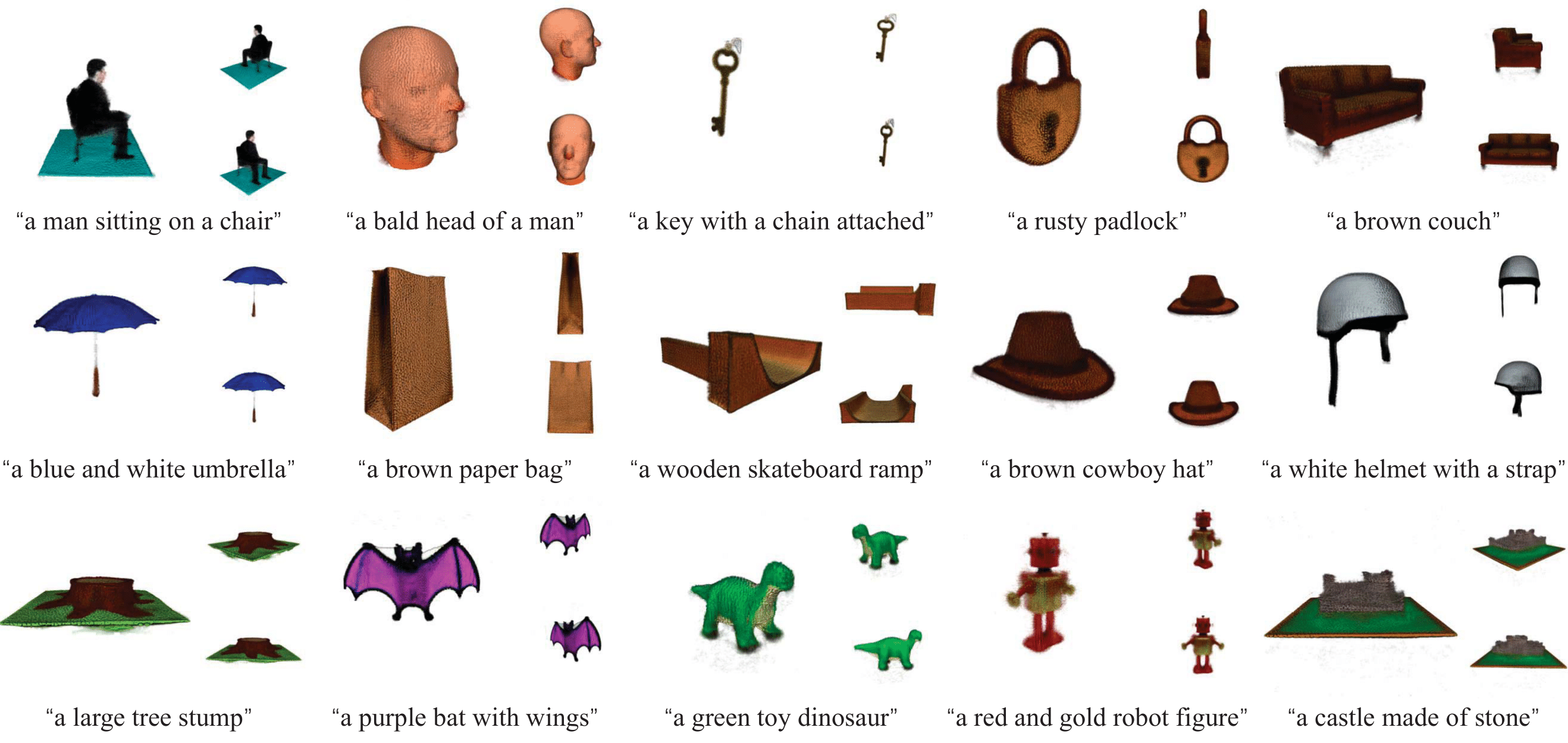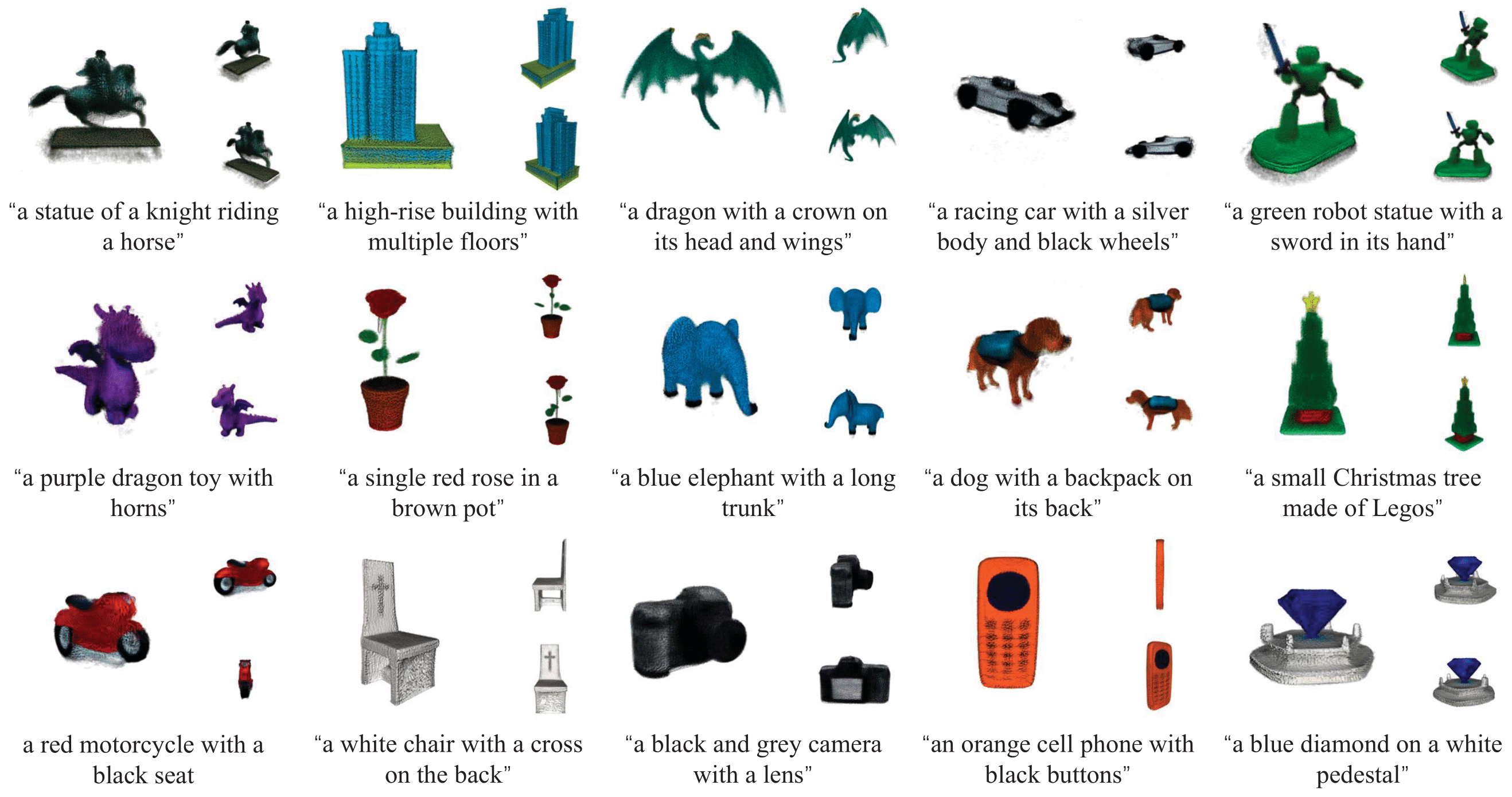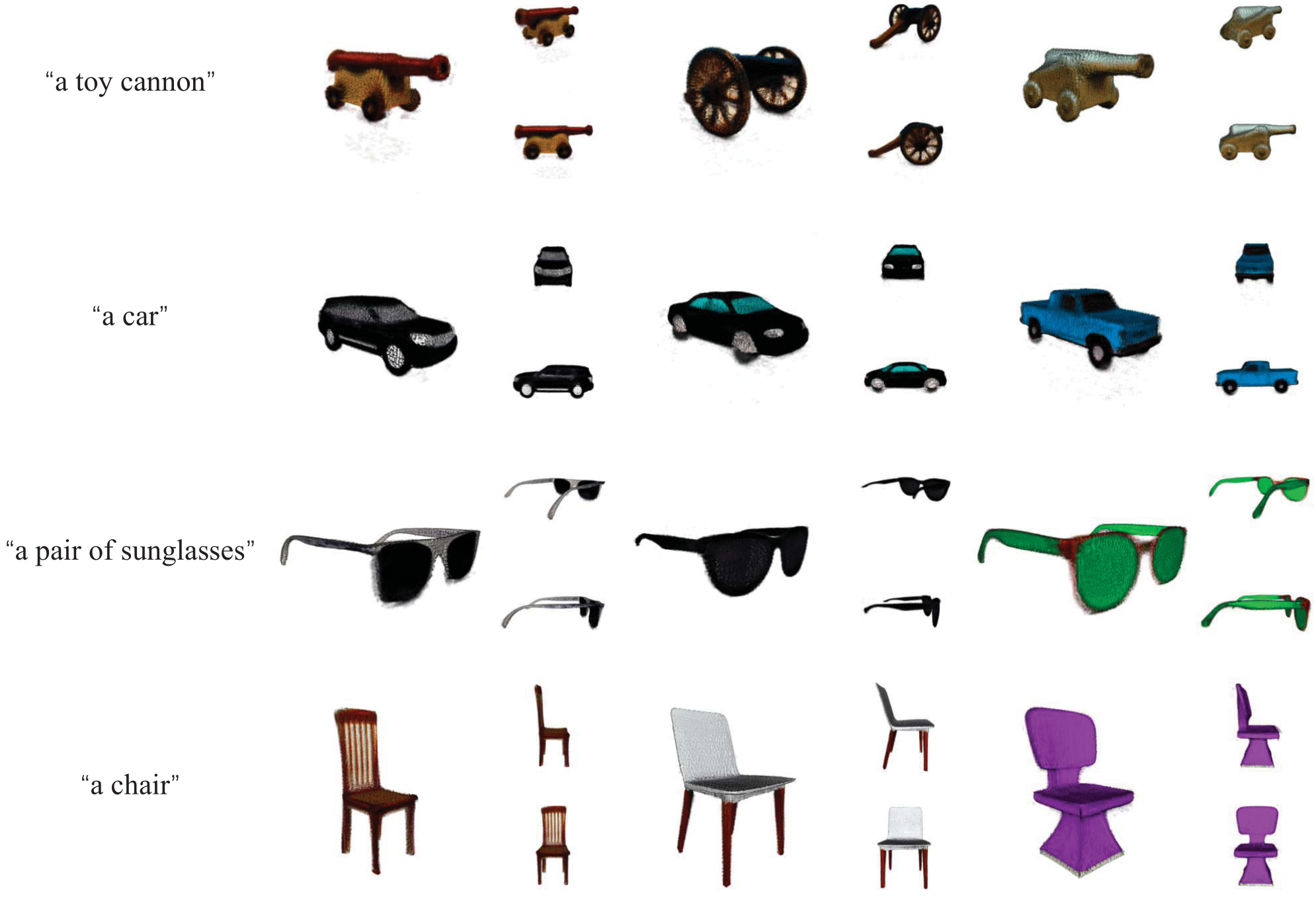---
license: mit
datasets:
- allenai/objaverse
language:
- en
tags:
- arxiv:2312.11459
---
# VolumeDiffusion
## Overview
This is the official repo of the paper [VolumeDiffusion: Flexible Text-to-3D Generation with Efficient Volumetric Encoder](https://arxiv.org/abs/2312.11459).
### TL;DR
VolumeDiffusion is a **fast** and **scalable** text-to-3D generation method that gives you a 3D object within seconds/minutes.
### Result
Generations 1 (Figure 5 in paper)


Generations 2 (Figure 9 in paper)


Generations 3 (Figure 10 in paper)


Diversity (Figure 11 in paper)

Flexibility (Figure 12 in paper)

### Method
 Framework of VolumeDiffusion. It comprises the volume encoding stage and the diffusion modeling stage.
The encoder unprojects multi-view images into a feature volume and do refinements.
The diffusion model learns to predict ground-truths given noised volumes and text conditions.
### Citation
```
@misc{tang2023volumediffusion,
title={VolumeDiffusion: Flexible Text-to-3D Generation with Efficient Volumetric Encoder},
author={Zhicong Tang and Shuyang Gu and Chunyu Wang and Ting Zhang and Jianmin Bao and Dong Chen and Baining Guo},
year={2023},
eprint={2312.11459},
archivePrefix={arXiv},
primaryClass={cs.CV}
}
```
## Installation
Run `sh install.sh` and start enjoying your generation!
We recommend and have tested the code with the docker image `pytorch/pytorch:2.1.0-cuda12.1-cudnn8-devel`.
## Inference
Download the [Volume Encoder](https://facevcstandard.blob.core.windows.net/t-zhitang/release/VolumeDiffusion/encoder.pth?sv=2023-01-03&st=2023-12-15T08%3A39%3A34Z&se=2099-12-16T08%3A39%3A00Z&sr=b&sp=r&sig=hzx4TL0DCMfL4p5%2BevF5OIgo5Plfj9Eevixz00QCPyU%3D) and [Diffusion Model](https://facevcstandard.blob.core.windows.net/t-zhitang/release/VolumeDiffusion/diffusion.pth?sv=2023-01-03&st=2023-12-15T08%3A38%3A44Z&se=2099-12-16T08%3A38%3A00Z&sr=b&sp=r&sig=oxuqYK6FSRiecxeSl1R5SbUW%2Bwiw0HQQNo6175YIn4k%3D) checkpoints and put them right here.
We use [DeepFloyd/IF-I-XL-v1.0](https://huggingface.co/DeepFloyd/IF-I-XL-v1.0) for refinement. Ensure you have the access and login with `huggingface-cli login --token your_huggingface_token`.
Then you can generate objects with
```
python inference.py --prompt "a yellow hat with a bunny ear on top" --image_channel 4
```
Also, you can use different prompts for diffusion generation and refinement. This is useful when generating complicated object with multiple concepts and attributes:
```
python inference.py --prompt "a teapot with a spout and handle" --prompt_refine "a blue teapot with a spout and handle" --image_channel 4
```
## Training
You can train with your custom dataset. We also provide `assets/example_data.zip` as an example of data format.
To train a volume encoder:
```
python train_encoder.py path/to/object_list path/to/save --data_root path/to/dataset --test_list path/to/test_object_list
```
To train a diffusion model:
```
python train_diffusion.py path/to/object_list path/to/save --data_root path/to/dataset --test_list path/to/test_object_list --encoder_ckpt path/to/trained_volume_encoder.pth --encoder_mean pre_calculated_mean --encoder_std pre_calculated_std
```
We recommend pre-calculating the `mean` and `std` of the outputs of the trained volume encoder on the dataset (or part of the dataset). This encourages the inputs close to the standard normal distribution and benefits the training of the diffusion model. Or you can directly set `mean=0` and `std=20`.
## Acknowledgments
This code borrows heavily from [stable-dreamfusion](https://github.com/ashawkey/stable-dreamfusion).
We use [threestudio](https://github.com/threestudio-project/threestudio) and do two minor modifications for the refinement stage.
We use [DeepFloyd/IF-I-XL-v1.0](https://huggingface.co/DeepFloyd/IF-I-XL-v1.0) model as supervision of the refinement stage.
We use [dpm-solver](https://github.com/LuChengTHU/dpm-solver) as the solver of diffusion model inference.
The codes of diffusion and UNet model are borrowed from [glide-text2im](https://github.com/openai/glide-text2im).
The codes of EMA are borrowed from [pytorch_ema](https://github.com/fadel/pytorch_ema).
Framework of VolumeDiffusion. It comprises the volume encoding stage and the diffusion modeling stage.
The encoder unprojects multi-view images into a feature volume and do refinements.
The diffusion model learns to predict ground-truths given noised volumes and text conditions.
### Citation
```
@misc{tang2023volumediffusion,
title={VolumeDiffusion: Flexible Text-to-3D Generation with Efficient Volumetric Encoder},
author={Zhicong Tang and Shuyang Gu and Chunyu Wang and Ting Zhang and Jianmin Bao and Dong Chen and Baining Guo},
year={2023},
eprint={2312.11459},
archivePrefix={arXiv},
primaryClass={cs.CV}
}
```
## Installation
Run `sh install.sh` and start enjoying your generation!
We recommend and have tested the code with the docker image `pytorch/pytorch:2.1.0-cuda12.1-cudnn8-devel`.
## Inference
Download the [Volume Encoder](https://facevcstandard.blob.core.windows.net/t-zhitang/release/VolumeDiffusion/encoder.pth?sv=2023-01-03&st=2023-12-15T08%3A39%3A34Z&se=2099-12-16T08%3A39%3A00Z&sr=b&sp=r&sig=hzx4TL0DCMfL4p5%2BevF5OIgo5Plfj9Eevixz00QCPyU%3D) and [Diffusion Model](https://facevcstandard.blob.core.windows.net/t-zhitang/release/VolumeDiffusion/diffusion.pth?sv=2023-01-03&st=2023-12-15T08%3A38%3A44Z&se=2099-12-16T08%3A38%3A00Z&sr=b&sp=r&sig=oxuqYK6FSRiecxeSl1R5SbUW%2Bwiw0HQQNo6175YIn4k%3D) checkpoints and put them right here.
We use [DeepFloyd/IF-I-XL-v1.0](https://huggingface.co/DeepFloyd/IF-I-XL-v1.0) for refinement. Ensure you have the access and login with `huggingface-cli login --token your_huggingface_token`.
Then you can generate objects with
```
python inference.py --prompt "a yellow hat with a bunny ear on top" --image_channel 4
```
Also, you can use different prompts for diffusion generation and refinement. This is useful when generating complicated object with multiple concepts and attributes:
```
python inference.py --prompt "a teapot with a spout and handle" --prompt_refine "a blue teapot with a spout and handle" --image_channel 4
```
## Training
You can train with your custom dataset. We also provide `assets/example_data.zip` as an example of data format.
To train a volume encoder:
```
python train_encoder.py path/to/object_list path/to/save --data_root path/to/dataset --test_list path/to/test_object_list
```
To train a diffusion model:
```
python train_diffusion.py path/to/object_list path/to/save --data_root path/to/dataset --test_list path/to/test_object_list --encoder_ckpt path/to/trained_volume_encoder.pth --encoder_mean pre_calculated_mean --encoder_std pre_calculated_std
```
We recommend pre-calculating the `mean` and `std` of the outputs of the trained volume encoder on the dataset (or part of the dataset). This encourages the inputs close to the standard normal distribution and benefits the training of the diffusion model. Or you can directly set `mean=0` and `std=20`.
## Acknowledgments
This code borrows heavily from [stable-dreamfusion](https://github.com/ashawkey/stable-dreamfusion).
We use [threestudio](https://github.com/threestudio-project/threestudio) and do two minor modifications for the refinement stage.
We use [DeepFloyd/IF-I-XL-v1.0](https://huggingface.co/DeepFloyd/IF-I-XL-v1.0) model as supervision of the refinement stage.
We use [dpm-solver](https://github.com/LuChengTHU/dpm-solver) as the solver of diffusion model inference.
The codes of diffusion and UNet model are borrowed from [glide-text2im](https://github.com/openai/glide-text2im).
The codes of EMA are borrowed from [pytorch_ema](https://github.com/fadel/pytorch_ema).









 Framework of VolumeDiffusion. It comprises the volume encoding stage and the diffusion modeling stage.
The encoder unprojects multi-view images into a feature volume and do refinements.
The diffusion model learns to predict ground-truths given noised volumes and text conditions.
### Citation
```
@misc{tang2023volumediffusion,
title={VolumeDiffusion: Flexible Text-to-3D Generation with Efficient Volumetric Encoder},
author={Zhicong Tang and Shuyang Gu and Chunyu Wang and Ting Zhang and Jianmin Bao and Dong Chen and Baining Guo},
year={2023},
eprint={2312.11459},
archivePrefix={arXiv},
primaryClass={cs.CV}
}
```
## Installation
Run `sh install.sh` and start enjoying your generation!
We recommend and have tested the code with the docker image `pytorch/pytorch:2.1.0-cuda12.1-cudnn8-devel`.
## Inference
Download the [Volume Encoder](https://facevcstandard.blob.core.windows.net/t-zhitang/release/VolumeDiffusion/encoder.pth?sv=2023-01-03&st=2023-12-15T08%3A39%3A34Z&se=2099-12-16T08%3A39%3A00Z&sr=b&sp=r&sig=hzx4TL0DCMfL4p5%2BevF5OIgo5Plfj9Eevixz00QCPyU%3D) and [Diffusion Model](https://facevcstandard.blob.core.windows.net/t-zhitang/release/VolumeDiffusion/diffusion.pth?sv=2023-01-03&st=2023-12-15T08%3A38%3A44Z&se=2099-12-16T08%3A38%3A00Z&sr=b&sp=r&sig=oxuqYK6FSRiecxeSl1R5SbUW%2Bwiw0HQQNo6175YIn4k%3D) checkpoints and put them right here.
We use [DeepFloyd/IF-I-XL-v1.0](https://huggingface.co/DeepFloyd/IF-I-XL-v1.0) for refinement. Ensure you have the access and login with `huggingface-cli login --token your_huggingface_token`.
Then you can generate objects with
```
python inference.py --prompt "a yellow hat with a bunny ear on top" --image_channel 4
```
Also, you can use different prompts for diffusion generation and refinement. This is useful when generating complicated object with multiple concepts and attributes:
```
python inference.py --prompt "a teapot with a spout and handle" --prompt_refine "a blue teapot with a spout and handle" --image_channel 4
```
## Training
You can train with your custom dataset. We also provide `assets/example_data.zip` as an example of data format.
To train a volume encoder:
```
python train_encoder.py path/to/object_list path/to/save --data_root path/to/dataset --test_list path/to/test_object_list
```
To train a diffusion model:
```
python train_diffusion.py path/to/object_list path/to/save --data_root path/to/dataset --test_list path/to/test_object_list --encoder_ckpt path/to/trained_volume_encoder.pth --encoder_mean pre_calculated_mean --encoder_std pre_calculated_std
```
We recommend pre-calculating the `mean` and `std` of the outputs of the trained volume encoder on the dataset (or part of the dataset). This encourages the inputs close to the standard normal distribution and benefits the training of the diffusion model. Or you can directly set `mean=0` and `std=20`.
## Acknowledgments
This code borrows heavily from [stable-dreamfusion](https://github.com/ashawkey/stable-dreamfusion).
We use [threestudio](https://github.com/threestudio-project/threestudio) and do two minor modifications for the refinement stage.
We use [DeepFloyd/IF-I-XL-v1.0](https://huggingface.co/DeepFloyd/IF-I-XL-v1.0) model as supervision of the refinement stage.
We use [dpm-solver](https://github.com/LuChengTHU/dpm-solver) as the solver of diffusion model inference.
The codes of diffusion and UNet model are borrowed from [glide-text2im](https://github.com/openai/glide-text2im).
The codes of EMA are borrowed from [pytorch_ema](https://github.com/fadel/pytorch_ema).
Framework of VolumeDiffusion. It comprises the volume encoding stage and the diffusion modeling stage.
The encoder unprojects multi-view images into a feature volume and do refinements.
The diffusion model learns to predict ground-truths given noised volumes and text conditions.
### Citation
```
@misc{tang2023volumediffusion,
title={VolumeDiffusion: Flexible Text-to-3D Generation with Efficient Volumetric Encoder},
author={Zhicong Tang and Shuyang Gu and Chunyu Wang and Ting Zhang and Jianmin Bao and Dong Chen and Baining Guo},
year={2023},
eprint={2312.11459},
archivePrefix={arXiv},
primaryClass={cs.CV}
}
```
## Installation
Run `sh install.sh` and start enjoying your generation!
We recommend and have tested the code with the docker image `pytorch/pytorch:2.1.0-cuda12.1-cudnn8-devel`.
## Inference
Download the [Volume Encoder](https://facevcstandard.blob.core.windows.net/t-zhitang/release/VolumeDiffusion/encoder.pth?sv=2023-01-03&st=2023-12-15T08%3A39%3A34Z&se=2099-12-16T08%3A39%3A00Z&sr=b&sp=r&sig=hzx4TL0DCMfL4p5%2BevF5OIgo5Plfj9Eevixz00QCPyU%3D) and [Diffusion Model](https://facevcstandard.blob.core.windows.net/t-zhitang/release/VolumeDiffusion/diffusion.pth?sv=2023-01-03&st=2023-12-15T08%3A38%3A44Z&se=2099-12-16T08%3A38%3A00Z&sr=b&sp=r&sig=oxuqYK6FSRiecxeSl1R5SbUW%2Bwiw0HQQNo6175YIn4k%3D) checkpoints and put them right here.
We use [DeepFloyd/IF-I-XL-v1.0](https://huggingface.co/DeepFloyd/IF-I-XL-v1.0) for refinement. Ensure you have the access and login with `huggingface-cli login --token your_huggingface_token`.
Then you can generate objects with
```
python inference.py --prompt "a yellow hat with a bunny ear on top" --image_channel 4
```
Also, you can use different prompts for diffusion generation and refinement. This is useful when generating complicated object with multiple concepts and attributes:
```
python inference.py --prompt "a teapot with a spout and handle" --prompt_refine "a blue teapot with a spout and handle" --image_channel 4
```
## Training
You can train with your custom dataset. We also provide `assets/example_data.zip` as an example of data format.
To train a volume encoder:
```
python train_encoder.py path/to/object_list path/to/save --data_root path/to/dataset --test_list path/to/test_object_list
```
To train a diffusion model:
```
python train_diffusion.py path/to/object_list path/to/save --data_root path/to/dataset --test_list path/to/test_object_list --encoder_ckpt path/to/trained_volume_encoder.pth --encoder_mean pre_calculated_mean --encoder_std pre_calculated_std
```
We recommend pre-calculating the `mean` and `std` of the outputs of the trained volume encoder on the dataset (or part of the dataset). This encourages the inputs close to the standard normal distribution and benefits the training of the diffusion model. Or you can directly set `mean=0` and `std=20`.
## Acknowledgments
This code borrows heavily from [stable-dreamfusion](https://github.com/ashawkey/stable-dreamfusion).
We use [threestudio](https://github.com/threestudio-project/threestudio) and do two minor modifications for the refinement stage.
We use [DeepFloyd/IF-I-XL-v1.0](https://huggingface.co/DeepFloyd/IF-I-XL-v1.0) model as supervision of the refinement stage.
We use [dpm-solver](https://github.com/LuChengTHU/dpm-solver) as the solver of diffusion model inference.
The codes of diffusion and UNet model are borrowed from [glide-text2im](https://github.com/openai/glide-text2im).
The codes of EMA are borrowed from [pytorch_ema](https://github.com/fadel/pytorch_ema).